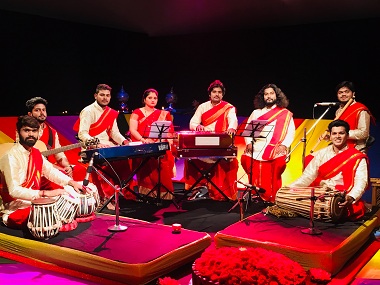The young find them ‘cool’. The elderly, sanskari. The only Sanskrit band in India, Dhruvaa, rocks the stage. Notwithstanding their traditional Indian attire—dhoti, kurta and _angvastram—_their approach to music is contemporary, albeit delivered in a classical format. Dhruvaa - The Sanskrit Band is unique, not because of the novel concept alone, but also because their music is both lifting and soulful. Though they sing in one language, the band members are as diverse as the cultural legacy they represent.
After two months of hard work with just eight members, Dr Dwivedi worked out a way to sing Sanskrit compositions in classical music, in a hummable, foot-tapping form. The band’s renderings are made engaging by three vocalists — Vaibhav, a Dhrupad singer, Gyaneshwari, a singer of khayals and Dr Dwivedi. They are supported by Vijay Gaur on the acoustic guitar, Amir on the sarod (who happens to be the grandson of Ustad Liyakat Ali Khan), Sagar on the keyboard, Swapnil Bagul on the tabla, Tushar on the pakhawaj, Manoj Chipleka on the acoustic drum, Rakesh on the flute and Yashwant Rao on the violin. Barring a few, most of these artistes come from the small towns of Madhya Pradesh. The band works with a fusion of two diverse musical streams. Composition are sung based on classical ragas, with accompanying traditional Indian instruments like the pakhawaj, tabla, flute, sarod and the harmonium. Then, the same composition is interpreted in a fast-paced version, such as with jazz, with the instruments of western music like the violin, acoustic guitar and acoustic drums. The challenge is to make sure it is not jarring and maintain the high aesthetic beauty of the language and the verses. Dhruvaa begins their show with ‘Prachand Tandav’, a fast, rhythmic composition of powerful alliterative syllables, followed by the Vedic richas. A very contemporary composition ‘The Dancing Ganesha’, reminds one of the foot-tapping elements of Latino music. They keep re-inventing their sound, working towards perfection. Some Sanskrit scholars believe the band has enhanced the beauty of the language. The first performance of the band in 2015 at Bhavabhuti Auditorium, Bhopal came as a pleasant surprise to a small gathering of about 300 people. The audience collected Rs 11,000 as reward for the unique initiative. “This was encouraging, even though we had spent more on booking the hall and other technical requirements.” Within two years, after a few bad experiences, the band had learnt their lesson — Sanskrit is not for charity. They became professionals and never had to look back. “We are like any other musical band, with all kinds of technical requirements, and that includes expenditure on sound and light equipment,” he adds.
The popularity and success of Dhruvaa is also an indicator of changing times; of greater interest in heritage and culture. In 1996, selected compositions of Kalidasa’s Meghdootam were composed by Pt Vishwa Mohan Bhatt. The music, produced by Music Today, had compositions sung by Kavita Krishnamoorty and A Hariharan in Sanskrit, with the accompaniment of classical instruments like the veena and mridangam. It didn’t find much success. Last year, the band created a record of sorts by performing four shows for 35 days without a break at different locations in Onkareshwar, MP. “ We had to take a workshop and train more musicians to meet the demand,” says Dr Dwivedi.
)